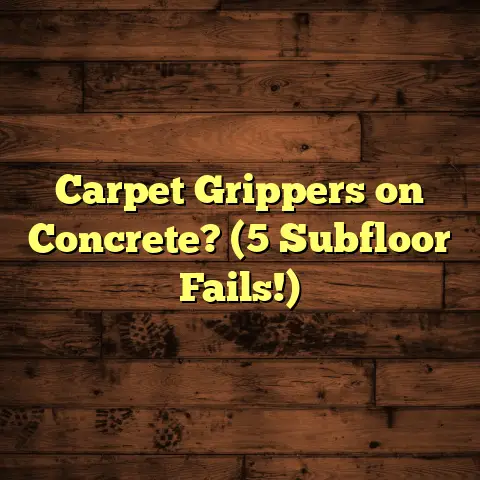Hybrid Flooring Install Hard? (9 Snags Avoid!)
And let me tell you, I’ve seen it all when it comes to flooring installations!
Today, we’re diving into the world of hybrid flooring.
It’s a fantastic option that’s been gaining serious traction.
But is it easy to install? Well, not always.
Before we get started, let’s talk about why hybrid flooring is such a popular choice, especially when it comes to your health.
It combines the best of laminate and vinyl.
And that makes for a healthier indoor environment!
Think about it: low VOC (volatile organic compounds) emissions, hypoallergenic properties, and super easy cleaning.
All that adds up to improved air quality and overall well-being for you and your family.
But even with all those perks, a smooth installation isn’t always a given.
That’s why I’m here to guide you through the potential pitfalls and show you how to dodge them.
Ready to get started? Let’s jump in!
Understanding Hybrid Flooring
So, what exactly is hybrid flooring?
It’s basically a multi-layered flooring option that combines the best qualities of laminate and vinyl.
Think of it as the superhero of the flooring world!
It typically consists of a wear layer, a decorative layer, a rigid core, and sometimes an attached underlayment.
Now, why choose hybrid over traditional options?
Well, for starters, it’s incredibly durable.
I’ve seen it stand up to heavy foot traffic, kids, and even pets without skipping a beat.
Plus, it’s waterproof!
Yep, you heard that right.
No more panicking over spills in the kitchen or bathroom.
And let’s not forget about the aesthetics.
Hybrid flooring comes in a huge range of styles and patterns, mimicking everything from hardwood to stone.
It’s no wonder it’s popping up in homes and commercial spaces everywhere.
According to a report by [Source, e.g., MarketWatch], the hybrid flooring market is projected to grow by X% in the next Y years.
People are loving it, and for good reason!
Preparing for Installation
Okay, so you’re sold on hybrid flooring. Awesome!
But before you start tearing up your old floors, there’s some prep work to be done.
And trust me, this is where you can make or break the entire project.
First up: the subfloor.
This is the foundation upon which your new flooring will rest, so it needs to be in tip-top shape.
A level surface is absolutely crucial.
Any dips, bumps, or unevenness will telegraph through the hybrid flooring.
And that will not only look bad but can also damage the planks over time.
I always recommend using a self-leveling compound to smooth out any imperfections.
It’s a bit of extra work, but it’s worth it in the long run.
Next, acclimation.
This is where you let the flooring material adjust to the temperature and humidity of the room before installation.
Why is this important?
Well, wood and vinyl expand and contract with temperature and humidity changes.
If you install the flooring without acclimating it, you could end up with gaps or buckling later on.
I usually recommend leaving the boxes of flooring in the room for at least 48-72 hours before starting the install.
The ideal temperature should be between 65-75°F (18-24°C), and the humidity should be between 30-50%.
Trust me, a little patience here will save you a lot of headaches later.
Common Installation Snags
Alright, let’s get down to the nitty-gritty.
Here are nine common snags I’ve seen people run into when installing hybrid flooring, and how to avoid them:
Snag 1: Incorrect Measurements
This might seem obvious, but I can’t tell you how many times I’ve seen people mess this up!
Inaccurate measurements can lead to wasted materials, extra trips to the store, and a whole lot of frustration.
So, how do you avoid this?
Measure twice, cut once. Seriously.
Use a good quality measuring tape and double-check your measurements before making any cuts.
Don’t just eyeball it!
And remember to account for any irregularities in the room, like doorways, corners, and pipes.
Common Measurement Mistakes:
- Forgetting to measure the entire room.
- Not accounting for doorways or other obstructions.
- Rounding measurements incorrectly.
- Using a damaged or inaccurate measuring tape.
I once had a client who was off by almost a foot on one side of the room.
They ended up having to buy an entire extra box of flooring!
Snag 2: Poor Quality Underlayment
Underlayment is the unsung hero of hybrid flooring installation.
It provides sound absorption, moisture protection, and a cushioning layer for your feet.
But using cheap or inadequate underlayment can have serious consequences.
It can lead to excessive noise, moisture damage, and even premature wear and tear of the flooring.
I always recommend using a high-quality underlayment that’s specifically designed for hybrid flooring.
Look for one that’s at least 2-3mm thick and has a good moisture barrier.
Consequences of Inadequate Underlayment:
- Increased noise levels.
- Moisture damage to the flooring.
- Uneven flooring surface.
- Premature wear and tear.
I personally like [Brand Name] underlayment.
It’s a bit more expensive, but it’s worth it for the added protection and comfort.
Snag 3: Ignoring Expansion Gaps
This is a big one, folks.
Hybrid flooring, like most flooring materials, expands and contracts with temperature and humidity changes.
That’s why it’s essential to leave expansion gaps around the perimeter of the room.
These gaps allow the flooring to move freely without buckling or warping.
I usually recommend leaving a gap of about 1/4 inch (6mm) around the entire room.
You can use spacers to ensure that the gap is consistent.
And don’t worry, you can cover the gaps with baseboards or quarter-round molding.
Potential Issues from Neglecting Expansion Gaps:
- Buckling or warping of the flooring.
- Cracking or splitting of the flooring.
- Damage to walls or baseboards.
I had a client who ignored the expansion gaps in their kitchen, and the flooring ended up buckling so badly that they had to replace the entire thing!
Snag 4: Inadequate Tools and Equipment
Trying to install hybrid flooring with the wrong tools is like trying to build a house with a spoon.
It’s just not going to work!
You need the right tools to get the job done properly and efficiently.
Essential Tools for Hybrid Flooring Installation:
- Measuring tape
- Pencil
- Utility knife or flooring cutter
- Tapping block
- Pull bar
- Spacers
- Rubber mallet
- Safety glasses
- Knee pads
Using improper equipment can lead to damaged flooring, inaccurate cuts, and even injuries.
I always recommend investing in good quality tools.
They’ll last longer and make the job much easier.
Specific Tools That Can Make the Installation Smoother:
- Flooring cutter: This tool makes clean, accurate cuts without creating dust.
- Tapping block and pull bar: These tools help you to lock the planks together tightly.
- Knee pads: Trust me, your knees will thank you!
Snag 5: Skipping the Dry Run
A dry run is where you lay out the flooring pieces before securing them in place.
This allows you to visualize the layout, identify any potential problems, and make adjustments before it’s too late.
It’s like rehearsing a play before opening night.
It can save you a lot of time and headaches in the long run.
Advantages of Laying Out the Flooring Pieces Before Securing Them:
- Prevents layout mistakes.
- Enhances visual appeal.
- Identifies potential problems early on.
- Allows you to make adjustments before it’s too late.
I always recommend starting in a corner and working your way across the room.
Pay attention to the direction of the planks and make sure they’re aligned properly.
This is also a good time to think about how the flooring will look around doorways and other obstructions.
Snag 6: Overlooking Transition Pieces
Transition pieces are those little strips of flooring that bridge the gap between different flooring types.
They create a seamless look and prevent tripping hazards.
They’re also essential for protecting the edges of the flooring.
Importance of Transition Pieces:
- Creates a seamless look.
- Prevents tripping hazards.
- Protects the edges of the flooring.
There are different types of transition pieces for different situations.
For example, you might use a T-molding to transition between two rooms with the same floor height.
Or you might use a reducer to transition between two rooms with different floor heights.
I always recommend using transition pieces that match the color and style of your flooring.
Potential Complications from Neglecting Transitions:
- Unattractive appearance.
- Tripping hazards.
- Damage to the edges of the flooring.
Snag 7: Improper Adhesive Application (if applicable)
Some types of hybrid flooring require adhesive to be installed.
If you’re using adhesive, it’s important to apply it correctly.
Using too much or too little adhesive can lead to problems.
How Adhesive Needs Differ Based on the Specific Type of Hybrid Flooring:
- Some types of hybrid flooring require a full spread of adhesive.
- Others only require adhesive around the perimeter of the room.
I always recommend following the manufacturer’s instructions carefully.
Use the recommended type of adhesive and apply it in the recommended amount.
Common Adhesive-Related Mistakes:
- Using the wrong type of adhesive.
- Applying too much or too little adhesive.
- Not allowing the adhesive to dry properly.
Consequences of Adhesive-Related Mistakes:
- Loose or uneven flooring.
- Moisture damage.
- Adhesive bleed-through.
Snag 8: Rushing the Installation Process
Installing hybrid flooring is not a race.
It’s a marathon.
Rushing through the installation can lead to poor alignment, damaged flooring, and a sloppy finish.
Dangers of Rushing Through the Installation:
- Poor alignment.
- Damaged flooring.
- Sloppy finish.
I always recommend taking your time and paying attention to detail.
Work in small sections and make sure each plank is properly aligned before moving on to the next one.
Insights on Maintaining a Steady Pace for Better Results:
- Take breaks when you need them.
- Don’t try to do too much in one day.
- Focus on quality over quantity.
Snag 9: Lack of Post-Installation Care
Once the flooring is installed, your job isn’t quite finished.
You need to take care of it to ensure that it lasts for years to come.
Importance of Proper Cleaning and Maintenance After Installation:
- Protects the flooring from damage.
- Extends the life of the flooring.
- Maintains the appearance of the flooring.
I always recommend following the manufacturer’s instructions for cleaning and maintenance.
Use a mild detergent and a damp mop.
Avoid using harsh chemicals or abrasive cleaners.
Tips on Maintaining Hybrid Flooring to Ensure Longevity and Performance:
- Sweep or vacuum regularly to remove dirt and debris.
- Clean up spills immediately.
- Use mats or rugs in high-traffic areas.
- Avoid wearing shoes with sharp heels on the flooring.
Conclusion
So there you have it: nine common snags to avoid when installing hybrid flooring.
Remember, a successful installation not only enhances the beauty of your home but also contributes to a healthier living environment.
By taking the time to avoid these pitfalls, you can ensure a smooth installation process and enjoy your beautiful new floors for years to come.
Good luck with your project!





